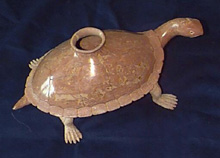Juan Mata Ortíz is a small village of potters, farmers and cowboys in Northern Chihuahua. About 30 years ago, an unschooled artistic genius, Juan Quezada, taught himself how to make earthenware jars in a method used hundreds of years ago by the prehistoric inhabitants. Now, his works are known worldwide and over 300 men, women and children in the village of less than 2000 make decorative wares. Much of the polychrome and blackware is feather light and exquisitely painted.
Many of the potters are also cowboys and farmers. These stories serve to document the art and the people in this unassuming pueblo, which is often called “magical” by the relative handful of tourists who visit. Enjoy this other view of Mexico. -Michael Williams.
An owl turns and looks inquisitively over his shoulder. A javelina snarls, bearing his fangs. A curiously colored tortoise pokes along, neck straining ahead of his shell with the effort of movement. A pair of rabbits-one all black, the other colored red and black-perch on their haunches with noses raised, sensing danger. All these animals form a peaceful menagerie, sitting together on a table in a small home in the humblest of the barrios of Mata Ortíz. They are the pets and creations of a magnificent sculptor and potter: Nicolas Ortíz.
The visitors gasp and mutter in disbelief after being invited into the adobe house by his wife Patricia. “Look how much he burnished that shell!” “Look at the action in that javelina!” “How did he do that?” There’s a scraping of a chair from a small room off the kitchen. A thump of feet and Nicolas emerges into the room. He is as imposing as his pottery, standing about 6’7″. But he has a warm smile, a deep mellow voice and a gracious personality.
” Buenos dias, how are you?” he says, displaying his partial bilingualism. Unlike most of the potters, Nicolas speaks some English and likes to use it. He walks with a slight unconscious stoop indoors, for most Mata homes have low overhead and there are always hanging light bulbs and ceiling fans to worry about.

When I first saw his turtle, or tortuga, I told him it was the finest piece of pottery I had ever seen come out of the village. It was a mixture of two clays, white and beige, and the colors swirled around the ceramic shell and over the legs and head. Not only the top but also the underside of that shell glistened from the stone polishing.
“I like to sculpt the wild creatures I see,” he says. His inspiration comes from the jackrabbits and desert turtles of the valley and the owls and javelina of the Sierras.
As his fame spreads and more and more orders arrive via guests or, occasionally, the town fax machine, Nicolas has become an accountant of sorts. Orders taken today will be ready for pick up (neither UPS nor DHL have made it to Mata Ortíz) in eight to nine months. Everything is meticulously kept in a notebook-date of order, anticipated completion, name of buyer, description of piece desired and both amount of deposit paid and total price of the finished earthenware.
“Sometimes I don’t like to take a deposit,” Nicolas laughs with a grin. “Then when I am paid for the piece it seems I am not getting very much.” This tall, unassuming man with the shaggy beard is also an artist of another sort. He sings and plays several musical instruments, including the saxophone. I asked him if he had his druthers, which would he rather do, make pottery or make music. He thought for a moment and replied, “Both, half and half.”
Nicolas Ortíz: sculptor, potter, musician, Renaissance man.

